AvtoVAZ
AvtoVAZ (Russian: АвтоВАЗ), formerly known as VAZ (Volzhsky Avtomobilny Zavod) (ВАЗ, Во́лжский автомоби́льный заво́д, or Volga Automobile Plant),[10] is a Russian automobile manufacturer. It is best known for its flagship series of Lada vehicles. In the Soviet Union, its products used various names, including Zhiguli, Oka, and Sputnik which were phased out in the 1990s and replaced by Lada for the Russian market. Starting in December 2019, AvtoVAZ has been selling Niva cars with Chevrolet branding. That is set to end in August 2020.
 | |
Native name | АО АвтоВАЗ |
|---|---|
| Joint-stock company | |
| ISIN | RU0009071187 |
| Industry | Automotive |
| Founded | 1966 |
| Headquarters | Tolyatti, Samara Oblast, Russia |
Key people |
|
| Products | Automobiles |
| Brands | |
Production output | 618,795 vehicles (2018)[3][note 2] |
| Revenue | $3.87 billion[4] (2017) |
| -$11 million[4] (2017) | |
| -$165 million[4] (2017) | |
| Total assets | $1.96 billion[4] (2017) |
| Total equity | -$1.15 billion[4] (2017) |
| Owner | Alliance Rostec Auto B.V. (100%)[5] |
Number of employees | 36,413[6] (2018) |
| Parent | Groupe Renault[7][8][9] |
| Website | info |
The company is a subsidiary of the Alliance Rostec Auto company, in which French Groupe Renault holds a controlling 67.61% stake.[11][12] AvtoVAZ is a consolidated subsidiary of Groupe Renault.[8] AvtoVAZ produces over 400,000 cars a year,[13] under its Lada brand as well as cars of Renault–Nissan–Mitsubishi Alliance brands Renault, Nissan and Datsun. The AvtoVAZ factory is the largest car manufacturer in Russia and Eastern Europe.[14]
History
Establishment
The company was established in 1966 in cooperation with Fiat, with Viktor Polyakov (later Minister of Automobile Industry) as director, and Vladimir Solovyov as chief designer,[15] and intended to produce popular economy cars that would meet the growing demand for personal transport.[16] It was set up as a collaboration between Italy and the Soviet Union and built on the banks of the Volga River in 1966. A new town, Tolyatti, named after the Italian Communist Party leader Palmiro Togliatti, was built around the factory.[16] The cost of the VAZ plant was estimated at $800 million in 1970[17] (equivalent to $4.1 billion in 2018).[18] The plant contained many of the automation systems being developed by Fiat's various subsidiaries (which were eventually amalgamated as Comau), so the Togliatti factory acted as a trial before Fiat implemented them in its plants in Italy.
The car brand to be produced ("Zhiguli") was envisaged as a "people's car" like the Citroën 2CV or the VW Type 1. Production was intended to be 220,000 cars a year, beginning in 1971[19] (other sources listed 300,000 in 1971[17]); car production actually began before the plant was finished in 1970.[19] The VAZ trademark, at first, was a silver Volga boat on a red pentagonal background, with "Togliatti" superposed in Cyrillic (Тольятти); the first badges, manufactured in Turin, mistakenly had the Cyrillic "Я" rendered "R" instead (Тольʀтти), making them collector's items.[20]
Although the company was not as vertically integrated as other Soviet enterprises, for example it purchased components from a variety of suppliers over which it exerted little control.[21], unlike Western automakers, a large proportion of the components for the cars were made entirely in-house - for example the Togliatti works contained its own foundry for manufacturing steel from raw iron ore, and even made its own tyres and glass from raw materials.
1970s
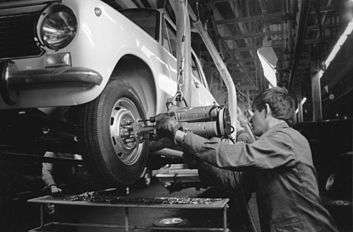
The first VAZ-2101 was produced on 22 April 1970, the 100th anniversary of Lenin's birth.[22] About 22,000 VAZ-2101s were built in 1970, with capacity at the end of 1973 reaching 660,000 a year; 21 December, the one millionth 2101 was built.[19] A third production line was added in October 1974, boosting output to 2,230 cars a day.[19] The same year, total VAZ production reached 1.5 million.[19]
The VAZ plant was described as 'ultra-modern' by the Chicago Tribune in a 1973 article.[23] Production reached 750,000 cars a year in 1975, making the Tolyatti plant the third most productive in the world.[24] Between 1977 and 1981, AvtoVAZ acquired 30 welding robots from Japanese firms.[25]
The original, Fiat-based models included the VAZ-2101 sedan and the VAZ-2102 estate. 1972 saw the introduction of a deluxe version of the sedan, VAZ-2103, which was based on the Fiat 124 Special and featured a new 1.5 L engine and twin headlights. In 1974, the original VAZ-2101 was updated with new engines and interiors, whereas the VAZ-2102 underwent the same improvements in 1976. The body style with two round headlights was manufactured until 1988.
The VAZ-2106, introduced in December 1975 as an updated version of the VAZ-2103, was based on the 1972 Fiat 124 Special T, featuring different interiors and new 1.6 L engine. The 2106 was one of the most popular rear-wheel drive AvtoVAZ models in the past; its production ended in 2001 from Tolyatti, but continued at Izhavto (Izhevsk), ending there in December 2005.
In 1974, VAZ was given permission to begin producing Wankel engines under licence from NSU.[26] Work began in 1976, with a single-rotor Lada appearing in 1978; the first 250 of these went on sale in the summer of 1980.[26]
After having built a number of prototypes and experimental vehicles, AvtoVAZ designers launched the first car entirely of their own design, the VAZ-2121 Niva, in 1977. This highly popular and innovative[27] SUV was made with off-road use in mind, featuring a gearbox with a central differential lock lever as well as a low- and high-range selector lever.
The VAZ-2105, based on the Fiat 124 mechanicals but modernised and restyled, was introduced in 1979 and marketed outside the Soviet Union under the Riva or Laika trade names, depending on the country. Square headlights and new body panels distinguish this car from the earlier models. The 2105 was third best selling automobile platform after the Volkswagen Beetle and the Ford Model T,[28][29] and one of the longest production run platforms alongside the Volkswagen Beetle, the Hindustan Ambassador and the Volkswagen Type 2.[30]
1980s
In May 1980, a series of mass strikes at the Togliatti plant involving hundreds of thousands of workers were reported by the western press.[31] In 1982 the VAZ-2107, a deluxe version of the 2105, was introduced; it featured a better engine, refined interiors and a chrome radiator grille. In 1984, the VAZ-2104 station wagon completed the line-up.
Based on the success of the Niva, the design department prepared a new family of front-wheel drive models by 1984, which was of a completely domestic design. Production started with the VAZ-2108 Sputnik three-door hatchback, the series was commercially known as Samara. It was the first front-wheel drive serial car built in the Soviet Union after the LuAZ- 969V.[32] The Samara engine was mostly designed and produced in-house, had a new single overhead camshaft (SOHC) design and was driven by a more modern rubber belt. The five-door VAZ-2109 hatchback followed in 1987, and the four-door 1.5 L sedan, the VAZ-21099, was introduced in 1990. The same year, the front sides and radiator grille were restyled on the whole Samara range.
A white 2108 would become the nine millionth Lada built, on 24 May 1985, with the ten millionth, on 9 October 1986, also a 2108.[33] The twelve millionth, a right-hand drive 2109, was produced 6 July 1989.[34]
The VAZ-1111 Oka micro-car was introduced in 1988, and in 1991 the production was transferred to the KamAZ and SeAZ factories.
By the late 1980s AvtoVAZ was suffering from the deterioration of its capital goods such as tools and machinery, resulting from insufficient levels of investment over a long period.[24] Unproductive and antiquated management techniques also contributed to the decline, as did the absence of market competition.[24]
The first privately owned AvtoVAZ dealership was established by Boris Berezovsky in 1989.[35] Dealerships quickly turned into criminal rackets that at times simply stole cars from the factory.[36]
Post-privatization
In June 1991 Bear Stearns was hired by the Soviet government to conduct an appraisal of AvtoVAZ and negotiate a venture with a Western partner, in preparation for the privatization of the company.[37] An independent trade union was started during the same year, as workers deemed the traditional trade union to be too close to the interests of management.[38]
In January 1993 AvtoVaz was re-established as a joint-stock company under Russian law.[39] The company came to be controlled by the management, including Vladimir Kadannikov, head of AvtoVAZ.[24] It was listed on the Moscow Stock Exchange.[40] As with many other privatized post-Soviet companies the financial situation at AvtoVAZ was dire, with workers being unpaid for months at a time.[41]
In 1994 Boris Berezovsky’s dealership company, called Logovaz, accounted for nearly 10% of the domestic sales of AvtoVAZ.[42] Despite the state of the Russian economy at the time demand for AvtoVAZ cars remained buoyant, but widespread corruption in the distribution network led the company to accumulate massive debts.[42]
The 110-series sedan was introduced in 1995, two years late on its original 1993 deadline.[38] Development costs for the car were estimated at $2 billion.[43] The 2111 station wagon followed in 1998 and the 2112 hatchback completed the range in 2001. A five-door version of the Niva, the VAZ-2131, was introduced in 1995.
By 1995 car sales, distribution and spare parts at AvtoVAZ were all controlled by criminal organizations.[41] This situation was made possible by the close relationship that existed between the criminals and part of the management.[41] Additionally, gangsters were used to control the workers and break strikes.[41]
By late 1996 AvtoVAZ had become the country's largest tax debtor, owing $2.4 billion in unpaid taxes.[44] In 1997, the Ministry of Internal Affairs launched Operation Cyclone,[42] an investigation which ultimately uncovered evidence that gangsters connected to AvtoVAZ had carried out at least 65 murders of company managers, dealers and business rivals.[42]
The 1998 Russian financial crisis improved the company's market position, by improving the effectiveness of export sales and making imported cars too expensive for most Russians.[40] The VAZ-2120 Nadezhda, a minivan based on the Lada Niva, was introduced in 1998. In the second half of the 1990s some efforts were made to improve the quality of production, but in 1999 there were still nearly 50,000 cases of cars being assembled with missing parts.[45]
In 2001 GM-AvtoVAZ, a joint-venture with General Motors, was established.[46] Increased competition from foreign car manufacturers saw the company's share of the Russian market fall to 49% in 2002, compared to 56% four years earlier.[45] In 2003, VAZ presented the concept car Lada Revolution, an open single seater sports car powered by a 1.6 L engine producing 215 hp (160 kW). Production of the Wankel engine used on some Lada models (mostly the police versions) stopped in 2004.[47]
2005 saw the introduction of the new Kalina B-segment lineup to the market. AvtoVAZ has built a new modern plant for this model and is hoping to sell some 200,000 cars annually. The Kalina had been originally designed in the early 1990s, and its launch was repeatedly delayed, exemplifying the company's difficulty in bringing products to market in time.[45]
In October 2005 the control of the company, which had until then been exercised by subsidiaries of AvtoVAZ connected to Kadannikov, was transferred to Rosoboronexport.[45][48] March 2007 saw the start of production of Lada Priora, a restyled and modernised 110-series model.[49]
Involvement of Renault-Nissan
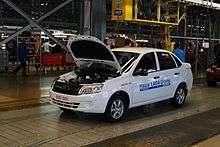
In March 2008, Renault purchased a 25% stake in AvtoVAZ in a US$1 billion deal, with Rostec retaining the remaining 75%.[50] The deal was agreed at a time when the Russian car market was booming.[51]
The onset of the Great Recession caused considerable problems to the company.[52] By April 2009 AvtoVAZ was on the verge of bankruptcy, which was only avoided because of $600 million bailout from the Russian government.[53]
As an anti-crisis measure, the Russian government introduced a car scrappage scheme in March 2010.[54] Avtovaz sales doubled in the second quarter of 2010 as a result, and the company returned to profit.[55][56] By the end of 2010, automotive production in Russia had returned to pre-crisis levels.[57][58]
In 2011 production of the classic Fiat 124-based 2105 and 2107 series models was completely moved from the Togliatti plant to the IzhAvto plant near Izhevsk,[59] to make space for the company's forthcoming 2016 model. In April 2012, AvtoVAZ confirmed the end of the model 2107 (Lada Riva or Lada Nova), after more than forty years.[60]
Sales of the Lada Granta, a subcompact car developed in collaboration with Renault, started in December 2011.[61] The Lada Largus was launched in the Russian market in the middle of July 2012.[62]
In August 2012, the Lada XRAY concept car was launched at the Moscow International Automobile Salon. The XRAY was designed by chief designer Steve Mattin, formerly of Volvo and Mercedes-Benz.[63] The second generation of the Lada Kalina, basically a facelifted first generation, was also revealed at the 2012 Moscow International Motor Show.[64] The Kalina is also produced as the more powerful version named Lada Kalina Sport.[65]
On 3 May 2012, the Renault-Nissan alliance has signed letter of intent to raise its stake in Avtovaz to 51.01%.[66] On 12 December 2012, the Renault–Nissan Alliance formed a joint venture with Rostekhnologii (Alliance Rostec Auto BV) with the aim of becoming the long-term controlling shareholder of AvtoVAZ.[67]
In the same year, it was announced that Avtovaz and Sollers plan to jointly produce vehicles in Kazakhstan.[68] The plant, which will be open in 2016, will be built in Ust-Kamenogorsk, in the eastern part of the country, and will produce around 120,000 cars a year.[69]
Recent developments

In November 2013, Bo Andersson joined AvtoVAZ as CEO,[70] the first non-Russian to head the company.[71] He became involved in conflicts with local suppliers, which he accused of supplying low-quality products.[72]
The takeover of AvtoVAZ was completed in June 2014, and the two companies of the Renault-Nissan Alliance took a combined 67.1% stake of Alliance Rostec, which in turn acquired a 74.5% of AvtoVAZ, thereby giving Renault and Nissan indirect control over the Russian manufacturer.[73]
In 2014, AvtoVAZ sold 448,114 vehicles, down 16.3 percent comparing to the previous year, due to the overall market slowdown in Russia.[74] The total production of the Togliatti factory is 910,000 vehicles.[75] By 2014 the company's liabilities exceeded assets by 68 billion rubles, for UK based Ernst & Young to express “significant doubt” about the company's “ability to continue as a going concern”.[76]
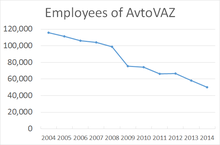
In 2014, the Largus got a new modification, the Lada Largus Cross.[62] In the fall of 2014 AvtoVAZ began production of a new Kalina model, the Lada Kalina Cross.[77]
Production of the Lada Vesta, based on a new b\C platform developed by AvtoVAZ in cooperation with Renault-Nissan Alliance, started on September 25, 2015, at Lada Izhevsk manufacturing site. For the first time in LADA history, one year has passed between concept-car and start of production.[78] Lada XRAY is the first compact city crossover in company’s history. Starts of sales was held on February 14, 2016.[79]
Total Lada sales in 2015 amounted to 269,096 cars, of which 207,389 were built by AvtoVAZ in Tolyatti, while the rest were made by Lada Izhevsk, giving the company a 17.9% share of the Russian automotive market.[13]
In March 2016 Nicolas Maure became the company's CEO.[80] In April 2016, Carlos Ghosn, Renault-Nissan Chairman, ceded his AvtoVAZ chairmanship position to Sergey Skvortsov, Deputy General Director of Russian state-owned Rostec, the minority shareholder in Avtovaz.[81][82]
Despite massive layoffs since 2008, in 2016 the company remained unprofitable.[83]
Groupe Renault takeover
In October 2016 Renault invested $1.33 billion in another recapitalization of AvtoVAZ, this time without involvement from Nissan, making the company a subsidiary of the French group.[84] In September 2017 Nissan sold its AvtoVAZ stake to Renault for €45 million.[85]
In December 2018, Renault and Rostec completed the acquisition of all AvtoVAZ shares through their Alliance Rostec venture.[5] The company then delisted from the Moscow Exchange.[86] In 2018 AvtoVAZ posted a net profit of $90.5 million, its first positive result in a decade.[87] In June 2019 Rostec announced it would reduce its stake in AvtoVAZ to 25%.[88]
In December 2019, AvtoVAZ acquired General Motors' stake in their GM-AvtoVAZ joint venture. As part of the deal, AvtoVAZ is set to use the Chevrolet branding for the Niva models[89] until August 2020, before replacing it with Lada.[90]
Company structure
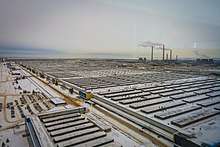
Ownership
After its re-establishment as a joint stock company in January 1993, the ownership structure of AvtoVAZ became opaque, with two different management groups controlling the majority of the shares, one led by company chairman Kadannikov, holding 33.2% through the AVVA company, while another group held 19.2% through the AFC company. AvtoVAZ, in turn, owned over 80% of AVVA, which was said to be under the influence of Boris Berezovsky.[21]
As of December 2018, AvtoVAZ's owner is Alliance Rostec Auto B.V., which is a joint venture of Renault and Russian company Rostec.[5] Renault owns a controlling 67.61% stake of Alliance Rostec Auto, while Rostec owns a 32.39%.[12] Following a recapitalization of AvtoVAZ in 2016, Renault holds over 50% of the company, making it a subsidiary of the French group.[7]
Subsidiaries
Production sites for Lada vehicles in Russia:[91]
- Tolyatti plant: 3 assembly lines, producing 312,000 cars in 2016;[92]
- Lada Izhevsk: one assembly line, producing 96,000 cars in 2016;[92]
- ChechenAvto: based in Argun, produced 6,700 cars in 2016.[93]
- PSA VIZ Avto: produced 4,146 cars in 2015. Includes VAZInterService – production of commercial vehicles based on Lada models, and PSA Bronto – production of off-road and armored derivatives of Lada cars.[94]
- Lada Sport: produced 3,153 cars in 2015.[94]
- Super-Avto: produced 569 cars in 2015.[94]
Currently produced models
Developed by AvtoVAZ
- Lada 4x4 (off-road car, also known as VAZ-2121, VAZ-2131 and Lada Niva since 1977)
- Lada Granta (subcompact car, also known as VAZ-2190, VAZ-2191, VAZ-2192 and VAZ-2194 since 2011)
- Lada Vesta (compact car, since 2015)
- Lada XRAY (crossover, since 2016)
Developed by other companies
- Lada Niva[95] (since 1998, previously known as VAZ-21236 and Chevrolet Niva)
- Lada Largus (since 2012)
- Renault Logan (since 2014, known in European markets as the Dacia Logan)
- Renault Sandero (since 2014, known in European markets as the Dacia Sandero)
- Datsun on-Do (since 2014)
- Datsun mi-Do (since 2015)
Export
Exports of AvtoVAZ vehicles to the West began in 1974; Ladas were sold as in several Western nations during the 1970s and 1980s, including Canada, the United Kingdom, France, Belgium, Luxembourg and the Netherlands, though trade sanctions banned their export to the United States. Under the original agreement with Fiat, the car could not be sold in competition with the 124 until its replacement (the Fiat 131 Mirafiori) had been released and all Fiat production of the 124 had ceased.
Economic instability in the former Soviet Union in the 1990s, tightening emissions and safety legislation meant that AvtoVAZ withdrew from most Western markets by the late 1997. In later years, Lada is again exported. The Lada is marketed in Russia, Azerbaijan, Armenia, Belarus, Bolivia, Bulgaria, Chile, Egypt, Georgia, Germany, Hungary, Kazakhstan, Kyrgyzstan, Latvia, Lithuania, Lebanon, Moldova, Slovakia, Tajikistan, Turkmenistan, Ukraine, Uzbekistan, South Ossetia, Serbian Republic, Syria, Peru and Jordan.[96]
In 2015, 28,461 Lada cars were exported, mostly to Kazakhstan (14,278 vehicles), Azerbaijan (4,690), Belarus (2,360), Egypt (2,128) and Germany (1,515).[13]
Motorsport
.jpg)
In 1970, AvtoVAZ CEO Viktor Polyakov set the task to create sport versions of the Lada 2101. The engines were built in Italy, whereas fine tuning was done by engineers in Togliatti. In 1971, three sport cars based on the 2101 model took part in the Soviet Winter Rally Championship.[97] Later in the same year, a VAZ-Autoexport team earned their first prize, the Silver Cup in the 1971 Tour d'Europe.[98]
In the 1970s–1980s, the Autoexport racing team, using different Lada models, participated in different motorsport competitions. A special Zhiguli class was created for the Soviet Rally Championship. There were different rally and track races featuring Avtovaz sports cars. In 1978, a Lada Niva took part in the famous Dakar Rally. It was also successful in a number of international competitions.[99] In 1981, Guy Moerenhout Racing made two special models for Lada Belgium: Lada 21011 RS Sport, model with two Weber carburetors and special sport equipment, and Lada Niva Dream, with big wing extension, special colours and larger wheels. In the late 1990s, Lada Canada supported a rally operation in the Canadian Rally Championship, winning in the 'Production 1750' class on numerous occasions.
In 2012, the Lada Granta Cup was launched. The first stage of the new race series began in Moscow on the Myachkovo race track.[100]
World Touring Car Championship
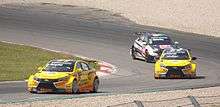
In 2008, AvtoVAZ took part in the WTCC World Championship, raced and developed by Russian Bears Motorsport, although badged as a factory team. The team raced the Lada 110 in the 2008 season, but ran a trio of Lada Prioras in the 2009 WTCC. The team scored their first championship points at Imola with renowned BTCC two-time champion James Thompson.
Lada withdrew from the WTCC for the 2010 season, but returned in 2012, with TMS Sport entering a Lada Granta WTCC for Thompson in two rounds. The team added a second car for the 2013 season, driven by Alexey Dudukalo, and achieved their best result to date, finishing fifth in their home race in Russia.
In 2013, AvtoVAZ returned to the WTCC championship. The team received a new car: the Lada Granta WTCC with the new driver, WTCC World Champion Robert Huff.[101]
The team returned for the 2014 World Touring Car Championship season,[102] again fielding a Granta. Since the beginning of 2015, the Lada team takes part in the WTCC as Lada Sport Rosneft.[103] Starting with the 2015 season, Lada Sport currently uses Lada Vesta.
Sponsorship
HC Lada Togliatti, an ice hockey team currently playing in the VHL, takes its name from the marque. They won two league titles as well as the 1996 European Cup.
Lada sponsored Aldershot Football Club of the English Football League for two seasons leading up their bankruptcy in 1992. Lada also sponsored Colo Colo (Chile) during their championship season in 1991.
Lada sponsored the Renault F1 Team in 2010 after they signed Russia's first Formula One driver Vitaly Petrov.[104]
See also
- List of AvtoVAZ vehicles
- Automotive industry in the Soviet Union
- Automobile model numbering system in USSR and Russia
Notes
- After acquiring the General Motors stake in the GM-AvtoVAZ joint venture, AvtoVAZ kept the right to use Chevrolet branding on the Niva models for "a certain period of time". The brand usage by AvtoVAZ is set to end in August 2020.
- Includes both KDs and fully assembled vehicles badged as Lada, Renault, Nissan and Datsun.
References
- "Alliance Rostec Auto BV annonces new CEO of AvtoVAZ" (Press release). Lada (AvtoVAZ). 15 April 2018. Retrieved 30 June 2018.
- "AVTOVAZ NAMES NEW BOARD MEMBERS" (Press release). Renault. 17 June 2019. Retrieved 26 June 2019.
- "Facts and figures 2018" (PDF). Renault. p. 10. Retrieved 10 November 2019.
- "Consolidated statement of financial position as at 31 December 2017"; determination method: International Financial Reporting Standards; retrieved: 24 October 2018; publisher: AvtoVAZ.
- "Renault et Rostec montent à 100% dans Avtovaz" [Renault and Rostec acquire 100% of AvtoVAZ]. Le Figaro (in French). 27 December 2018. Retrieved 29 December 2018.
- "АвтоВАЗ: рабочие места". АвтоВАЗ. Retrieved July 8, 2019.
- "Renault to Bailout Russia's Avtovaz, Maker of Lada Cars". Fortune. Archived from the original on 24 April 2017. Retrieved 23 April 2017.
- "2016/2017 Annual Report" (PDF). Renault. p. 19. Retrieved 15 June 2017.
- "BRIEF-Renault now holds over 50 pct of Alliance Rostec Auto BV". Ward's. 6 January 2017. Retrieved 20 January 2018.
- Clarity, James F. (18 August 1970). "Moscow Is Rushing Into an Era of Traffic Congestion". The New York Times. Archived from the original on 6 July 2017. Retrieved 5 July 2017.
- "Renault et Rostec montent à 100% dans Avtovaz". Le Figaro. 27 December 2018.
- "RENAULT ET ROSTEC AUGMENTENT LEUR PARTICIPATION DANS LE CAPITAL D'AVTOVAZ À 100%" [Renault and Rostec increase its AvtoVAZ stake to 100%]. capital.fr (in French). 27 December 2018. Retrieved 29 December 2018.
- "ОАО «АВТОВАЗ» Годовой Отчёт-2015" (PDF). Retrieved 24 June 2017.
- ""АвтоВАЗ" во II квартале получил 1 млрд руб чистой прибыли". Archived from the original on 2011-02-10.
- Thompson, Andy. Cars of the Soviet Union (Haynes Publishing, Somerset, UK, 2008), p.104.
- "AVTOVAZ Joint Stock Company History". Archived from the original on 2015-11-24.
- Salpukas, Agis (13 October 1970). "Fiat's Soviet Unit to Profit 'little'". The New York Times. Retrieved 2018-01-21.
- Thomas, Ryland; Williamson, Samuel H. (2019). "What Was the U.S. GDP Then?". MeasuringWorth. Retrieved April 6, 2019. United States Gross Domestic Product deflator figures follow the Measuring Worth series.
- Thompson, p.106.
- Thompson, pp.107 & 109.
- Ireland, R. Duane; Hoskisson, Robert; Hitt, Michael (2005). Understanding Business Strategy: Concepts and Cases. Cengage Learning. pp. 143–145. ISBN 032428246X. Retrieved 6 July 2017.
- Nettleton, Nordica (1 June 2006). "Driving Towards Communist Consumerism". Cahiers du monde russe. Russie – Empire russe – Union soviétique et États indépendants (in French). pp. 131–151.
- "Togliatti: Russia's answer to Detroit". Chicago Tribune. June 3, 1973. Retrieved 5 July 2017.
- Glazunov, Mikhail (2013). Business in Post-Communist Russia: Privatisation and the Limits of Transformation. Routledge. p. 72. ISBN 9781135021504.
- "Inside Report (6)". Christian Science Monitor. 8 January 1982. Archived from the original on 29 September 2015. Retrieved 5 July 2017.
- Thompson, p.209.
- Thompson, p.238.
- Kowalke, Ron (1997). Standard Catalog of American Cars 1946–1975. Krause publications. ISBN 0-87341-521-3.
- Giles Chapman (1 September 2005). Car emblems: the ultimate guide to automotive logos worldwide. Merrell. p. 154. ISBN 978-1-85894-317-6. Archived from the original on 12 October 2013. Retrieved 2 October 2013.
Combined with the Fiat 1 24, it's the third best- selling single model design of all time, after the Volkswagen Beetle and Ford Model T.
- "The Oldest Cars Still In Production". Jalopnik. 14 May 2012. Archived from the original on 1 January 2014. Retrieved 31 December 2013.
- Kose, Kevin (14 June 1980). "Massive Walkouts Reported at 2 Main Soviet Auto Plants". The Washington Post. Retrieved 5 July 2017.
- Thompson, p.251
- Thompson, p.253.
- Thompson, p.255.
- "Boris Berezovsky". Encyclopedia Britannica. Archived from the original on 26 April 2017. Retrieved 25 April 2017.
- "Godfather of the Kremlin?". Forbes. 30 December 1996. Archived from the original on 19 April 2017. Retrieved 25 April 2017.
- "A Light At End Of The Turmoil". Chicago Tribune. Retrieved 5 July 2017.
- Uchitelle, Louis (23 July 1992). "Russia's Motor City – A special report.; Russian Auto Maker Follows A Survival Blueprint: Exports". The New York Times. Archived from the original on 29 September 2009. Retrieved 5 July 2017.
- "Волжский автомобильный завод". Nashi Avto. Archived from the original on 26 April 2017. Retrieved 25 April 2017.
- "International Business, Update 2003 Cases General Motors and AvtoVAZ of Russia". Swlearning. Retrieved 6 July 2017.
- Glazunov, Mikhail (2013). Business in Post-Communist Russia: Privatisation and the Limits of Transformation. Routledge. p. 81. ISBN 9781135021504.
- Klebnikov, Paul (4 September 2000). "The Rise Of An Oligarch". Forbes. Archived from the original on 10 October 2014. Retrieved 1 July 2017.
- Ireland, R. Duane; Hoskisson, Robert; Hitt, Michael (2005). Understanding Business Strategy: Concepts and Cases. Cengage Learning. p. 142. ISBN 032428246X. Archived from the original on 2017-09-25.
- "Slow Death". The Moscow Times. Retrieved 1 July 2017.
- Glazunov, Mikhail (2013). Business in Post-Communist Russia: Privatisation and the Limits of Transformation. Routledge. p. 86. ISBN 9781135021504.
- "GM agrees to form joint venture with Russian company AvtoVAZ". Deseret News. 27 February 2001. Retrieved 5 July 2017.
- Thompson, p.237.
- Buckley, Neil (24 November 2005). "Russian state expands drive to reimpose control over strategic sectors". Financial Times. Retrieved 1 July 2017.
- "Lada Priora with robotized transmission will appear in the mid-2014". eng.autostat.ru. Archived from the original on 2015-12-22. Retrieved 2015-09-14.
- Madslien, Jorn (2008-03-02). "Lada deal highlights Russia's auto boom". BBC News. Archived from the original on 2008-03-05. Retrieved 2014-07-07.
- "Renault buys stake in Lada owner". BBC News. Archived from the original on 6 April 2016. Retrieved 5 July 2017.
- Aervitz, Irina (2009-04-08). "AvtoVAZ: a New Beginning or a Dead End?". Russia Profile. Archived from the original on 11 May 2009. Retrieved 2009-06-13.
- "Lada carmaker to cut 27,600 jobs". news.bbc.co.uk. BBC News. Archived from the original on 8 March 2016. Retrieved 5 July 2017.
- "Russia's car sector stalls, but foreigners still investing". Russia Beyond the Headlines. 5 June 2010.
- "Avtovaz in profit thanks to Russia car scrappage scheme". BBC News. 12 June 2010. Archived from the original on 29 June 2011.
- Rozhnov, Konstantin (7 March 2010). "What will save the Russian car industry?". BBC News. Archived from the original on 11 March 2010.
- "Car production reaches pre-crisis level". Voice of Russia. 13 December 2010. Archived from the original on 1 April 2012. Retrieved 13 December 2015.
- "Prime Minister Vladimir Putin is confident that the automotive industry in Russia's Far East has a future". Premier.gov.ru. 7 December 2010. Archived from the original on 6 October 2011.
- "The cheapest Russian car was removed from production". Autostat. Archived from the original on 2014-01-01. Retrieved 2011-02-14.
- Knapman, Chris (18 Apr 2012). "Lada 2107 production ceases after more than 40 years Production of the Lada 2107, better known in the UK as the Lada Riva, will end next week after more than 40 years". telegraph.co.uk. Archived from the original on 24 April 2012. Retrieved 25 April 2012.
Lada continues to produce models including the Kalina, Priora and Granta.
- "AvtoVAZ began sales of sedan Lada Granta with "robot"". Archived from the original on 2015-11-24. Cite journal requires
|journal=(help) - "Lada Largus Cross will be produced in two versions". eng.autostat.ru. Archived from the original on 2015-12-22. Retrieved 2015-09-14.
- "Goodbye Lada Classic – hello XRAY". bbc.co.uk. 2012-09-22. Archived from the original on 2012-11-22. Retrieved 2014-07-07.
- "Autonews". Archived from the original on 2015-12-22.
- "New Lada Kalina Sport will receive two engines". eng.autostat.ru. Archived from the original on 2015-12-22. Retrieved 2015-09-14.
- Reuters (3 May 2012). "Renault-Nissan to Take Control of AvtoVAZ". New York: NYTC. ISSN 0362-4331. Archived from the original on 7 May 2012. Retrieved 27 July 2012.
- "Renault-Nissan and Russian Technologies Create Joint Venture to Finalize Strategic Partnership with Avtovaz" (Press release). Renault-Nissan Alliance. 12 December 2012. Archived from the original on 23 October 2013. Retrieved 27 January 2014.
- "Russia's Avtovaz and Sollers to produce cars in Kazakhstan — RT". Rt.com. Archived from the original on 2012-10-20. Retrieved 2012-10-21.
- "120 тысяч казахстанских авто в год будут производить в Усть-Каменогорске". Tengrinews.kz. Archived from the original on 11 October 2014. Retrieved 15 July 2015.
- "AvtoVAZ appoints ex-GM executive Andersson as first non-Russian chief". europe.autonews.com. Automotive News Europe. November 5, 2013. Retrieved November 6, 2013.
- "AvtoVAZ chief Andersson in struggle with Soviet-era suppliers". Automotive News. Retrieved 8 July 2017.
- "A Foreigner With No Friends: Bo Andersson Pushed From Russia's AvtoVAZ". Archived from the original on 29 July 2016. Retrieved 8 July 2017.
- "Renault-Nissan completes deal to take control of AvtoVAZ". Automotive News Europe. 27 June 2014. Retrieved 1 July 2014.
- Written by epp on February 4, 2015 (2015-02-04). "Renault-Nissan Alliance Sales Rise For Fifth Straight Year In 2014 To 8.5 Million Vehicles". Media Room Alliance Renault-Nissan. Archived from the original on October 4, 2016. Retrieved 2017-06-25.
- "Most Russian car plants are uncompetitive, AvtoVAZ CEO says". Europe.autonews.com. 2015-06-15. Retrieved 2017-06-25.
- "Russia needs to send out the right message on Avtovaz's problems". Financial Times. Archived from the original on 19 August 2017. Retrieved 19 August 2017.
- "AVTOVAZ to introduce Lada Kalina and Lada Largus preudocrossovers in Autumn". eng.autostat.ru. Archived from the original on 2015-12-22. Retrieved 2015-09-14.
- "It's Halftime in Russia · Global Voices". Global Voices. Archived from the original on 2016-02-26. Retrieved 2016-03-02.
- "15 figures about LADA XRAY". eng.autostat.ru. Archived from the original on 2016-03-08. Retrieved 2016-03-02.
- "AvtoVAZ's new boss faces a tough job at Russian carmaker". europe.autonews.com. Automotive News Europe. March 16, 2016. Retrieved March 22, 2016.
- Laurence Frost and Gilles Guillaume (18 June 2016). "Ghosn will give up AvtoVAZ chairmanship amid restructuring". Automtive News Europe.
- "Renault's Ghosn cedes Avtovaz chairmanship to Rostec exec". Reuters. 18 June 2016. Archived from the original on 17 August 2016.
- "Objectif profits en 2018 pour Avtovaz (Renault-Nissan)". LExpansion.com (in French). 24 August 2016. Retrieved 30 November 2017.
- "Renault's Lada bailout raises bet on Russia". Reuters. 2016. Archived from the original on 20 February 2017. Retrieved 6 July 2017.
- "Nissan перестал быть акционером "АвтоВАЗа"". Vedomosti. 19 September 2017. Retrieved 29 November 2017.
- "AVTOVAZ is going for delisting". RusAutoNews.Com. 26 September 2018. Retrieved 5 June 2019.
- "Russian Automaker AvtoVaz Makes First Profit in a Decade". The Moscow Times. 2 May 2019. Retrieved 7 June 2019.
- "Rostec to sell Avtovaz stake to Renault for more than 10 billion..." Reuters. Reuters. 7 June 2019. Retrieved 12 June 2019.
- Stolyarov, Gleb; Marrow, Alexander (9 December 2019). "GM pulls out of Russian JV with AvtoVAZ". Automotive News Europe. Retrieved 17 February 2020.
- "АвтоВАЗ начал продавать Chevrolet Niva в своих салонах" [AvtoVAZ starts selling Chevrolet Nivas on its dealerships]. autonews.ru (in Russian). Retrieved 17 February 2020.
- "LADA: every third vehicle in Russia". LADA official website. Retrieved 25 June 2017.
- "AVTOVAZ Call with Financial Analysts" (PDF). Groupe Renault. Retrieved 25 June 2017.
- ""Chechenavto" is ready to increase the assembly of LADA cars in 2017". eng.autostat.ru. Retrieved 25 June 2017.
- "World Motor Vehicle Production Correspondents Survey" (PDF). OICA. Archived (PDF) from the original on 28 June 2017. Retrieved 7 July 2017.
- https://www.carscoops.com/2020/07/chevrolet-niva-regains-lada-badges-as-avtovaz-completes-gm-joint-venture-buyout/
- "Soviet Racing | English Russia | Page 2". Archived from the original on 2015-12-22. Retrieved 2015-09-18.
- witalii. "VAZ-2101. The history of the national car". russki-ya.blogspot.ru. Archived from the original on 2015-12-22. Retrieved 2015-09-18.
- Stuart, Greg. "7 of the best communist race cars". Archived from the original on 2015-12-22. Retrieved 2015-09-18.
- "LADA Granta CUP » High-Tech Racing Simulations". htracings.ru. Archived from the original on 2015-12-22. Retrieved 2015-09-18.
- "Rob Huff – LADA Sport ROSNEFT Driver – Official Website". www.robhuff.com. Archived from the original on 2015-11-13. Retrieved 2015-09-18.
- "Lada reveals 2014 World Touring Car Championship car". AUTOSPORT.com. 13 March 2014. Archived from the original on 15 July 2015. Retrieved 15 July 2015.
- "Rob Huff – LADA unveils new WTCC car and new sponsor for 2015–2017". www.robhuff.com. Archived from the original on 2015-12-22. Retrieved 2015-09-18.
- "Renault F1 Team Has A New Partner – Lada Enters Formula 1". Archived from the original on 2010-10-12. Retrieved 2015-09-18.
Further reading
- Siegelbaum, Lewis H. (2008). Cars for Comrades: The Life of the Soviet Automobile. Cornell University Press. ISBN 0-80-144638-4.
External links
| Wikimedia Commons has media related to AvtoVAZ. |
- Lada official website (in English)
- Lada official website (in Russian)
- Lada at Curlie
- Official history of Lada line-up (in Russian)
- Specifications cars AvtoVAZ (Lada)